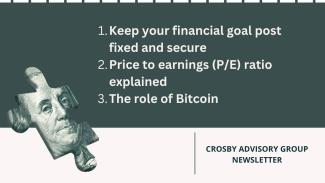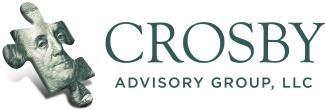
Fixing Goal Posts, P/E and Bitcoin as a Neutral Reserve Asset
Moving Target
Being a successful long-term investor is not easy. It's fairly simple, but not easy. Being a successful long-term investor is not just being able to find value before it begins to grow exponentially. If we are buying quality investments, time has a way of taking care of that on its own. In my opinion, one of the hardest parts of being a successful long-term investor is keeping your goal post from moving.

We are bombarded daily by news, social media, friends and family that nudge us to constantly reconsider what we want. This nudge could come in the form of a friend showing you a stock they bought that is up 100% but is now trading at over 600x its earnings. You realize it has likely run up too fast but what if it continues to grow and you miss out? Fear of missing out is a powerful persuader, even for seasoned investors who know better.
A nudge may come when your neighbor buys a boat and a bit of envy creeps in. You never considered owning a boat and certainly hadn’t included it in your budget, but the thought of sunset cruises or hauling in a monster fish while your family cheers you on is enticing. Perhaps it's the social media personality that you follow who buys and tries on new clothes every day. It could be the perma-bear uncle who gives you 17 reasons why society will implode in the next ten years and thus investing is a waste of time.
A nudge may come from the process of investing itself, especially with new investors. Compounding interest takes decades for it to work its magic. A $1,000 account that gets a 10% return only grows by $100 per year. A $500,000 account that grows by 10% increases by an amount that exceeds the average income in the United States. It takes time to be able to witness your account balance growing by leaps and bounds. What if there was a quicker way? Every investor has asked that question. The pursuit of the short-cut can lead to wasted years of chasing shiny objects.
How do you keep your financial goal post fixed and secured?
- Take some time to think about what you really want to achieve. If you are specific in what your true goal is, that will help you ignore distracting nudges from others. What does financial independence mean to you?
- Once you’ve answered that question, work with your advisor to calculate your accumulation goal. Once you have that number it can be reverse engineered to determine what you should be saving each paycheck and the rate of return, you’ll need to achieve the accumulation goal. The required rate of return will tell you and your advisor the types of investments that are appropriate.
- Write it down. We call this an Investment Policy Statement. It outlines the types of investments you will own, expected and required growth rate as well as expected short-term loss or risk. We also advise having a bear (down) market plan. Decide ahead of time how you will handle a down investment market so that you act appropriately when it happens.
Being clear on your goals and taking time to outline an investment strategy you can stick with through good times and bad will help keep your goals fixed as you gain ground on them.
Price to Earnings Ratio (P/E) Explained
For those who are stock pickers, one common ratio that investors use when evaluating a stock before purchase is known as the Price to Earnings Ratio or P/E for short. The ratio is determined by dividing the price of the stock per share by earnings per share. The resulting quotient (kids at home: a quotient is the answer to a division problem) tells us how much we are paying for the company's earnings. The price of a stock is constantly updated during stock market hours and earnings per share can be found on any publicly traded company’s financial reports. Thankfully you actually don’t have to go to much work to figure out a stock’s P/E ratio. Any stock’s P/E ratio is likely computed for you anywhere you may search for stocks. For example, a simple Google search of “Progressive Stock” will bring up the price chart below, along with basic information about Progressive stock. We see that as of July 2, Progressive stock was trading at a P/E ratio of 17.38. To put this in easy-to-understand English, if you bought the entire Progressive company based on its stock price and the company continued to generate revenue equal to its trailing 12 months, it would take you 17.38 years to break even on your purchase.

The P/E ratio by itself doesn’t tell the whole story. In theory, a lower P/E ratio may indicate a better value, but a company may be trading at a lower P/E because they are no longer growing at a significant rate, and investors are not willing to pay up for the company. A high P/E ratio also does not necessarily mean a bad value if the company is growing revenue at a significant rate. P/E ratios are best used to compare competitors or even the to a company's historic P/E ratio. For example, Erie Indemnity Company (also insurance) is trading at a P/E ratio of 29.50. Based on trailing 12-month earnings, an investor is getting more revenue per dollar from Progressive than they are from buying Erie Indemnity Company. P/E ratios are also good for comparing a company’s current P/E ratio to their P/E ratio of the past. A look at Progressive’s historic P/E ratio we would see that although its current P/E of 17.38 is not the highest its every been, on average it is currently trading a bit higher than its average historic P/E. Back in 2019 you could have picked Progressive stock up for a cheap, cheap P/E of 9.45 and the stock would have appreciated by an average compounding growth rate of 29% to present!
*Note when comparing company's P/E ratios know that they can be express in trailing 12 months (TTM) or forward P/Es which are based on analyst expectations. Just make sure you are comparing apples to apples.
Why Bitcoin Takes Pressure Off the US Dollar: The Case for Neutral Reserve Assets
Derek Ballinger authored the following opinion article was posted on our blog on June 25, 2025. You can read it here: Why Bitcoin Takes Pressure Off the US Dollar: The Case for Neutral Reserve Assets | Crosby Advisory Group, LLC
Disclaimer: Crosby Advisory Group, LLC is a registered investment Advisor providing financial planning, investment management, income planning and life insurance. Property Casualty insurance is sold through NMD Insurance an affiliated agency. Investing involves risk including the loss of principal. Not all investments are suitable for all investors. Understand all risk and fees before investing.

